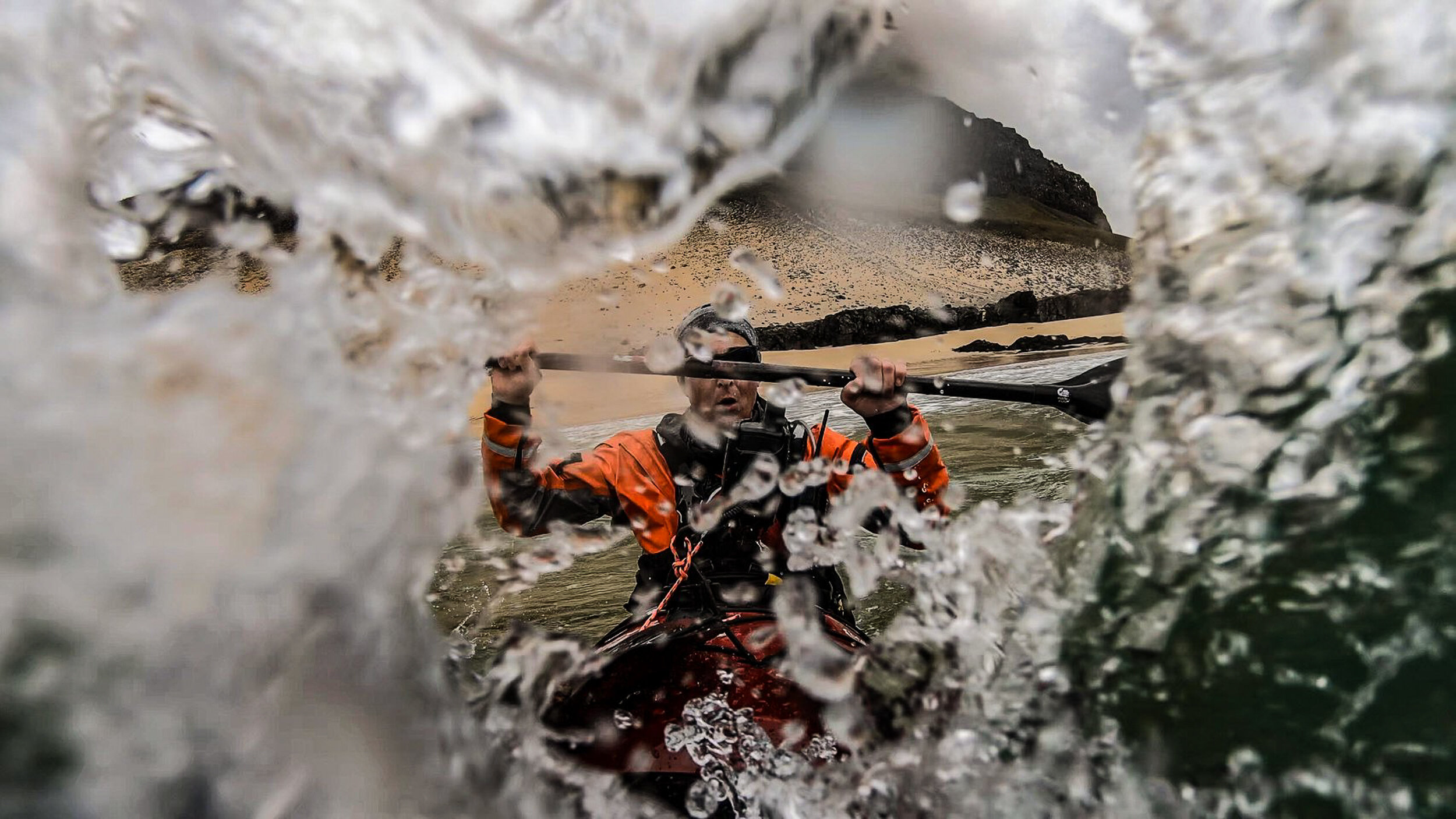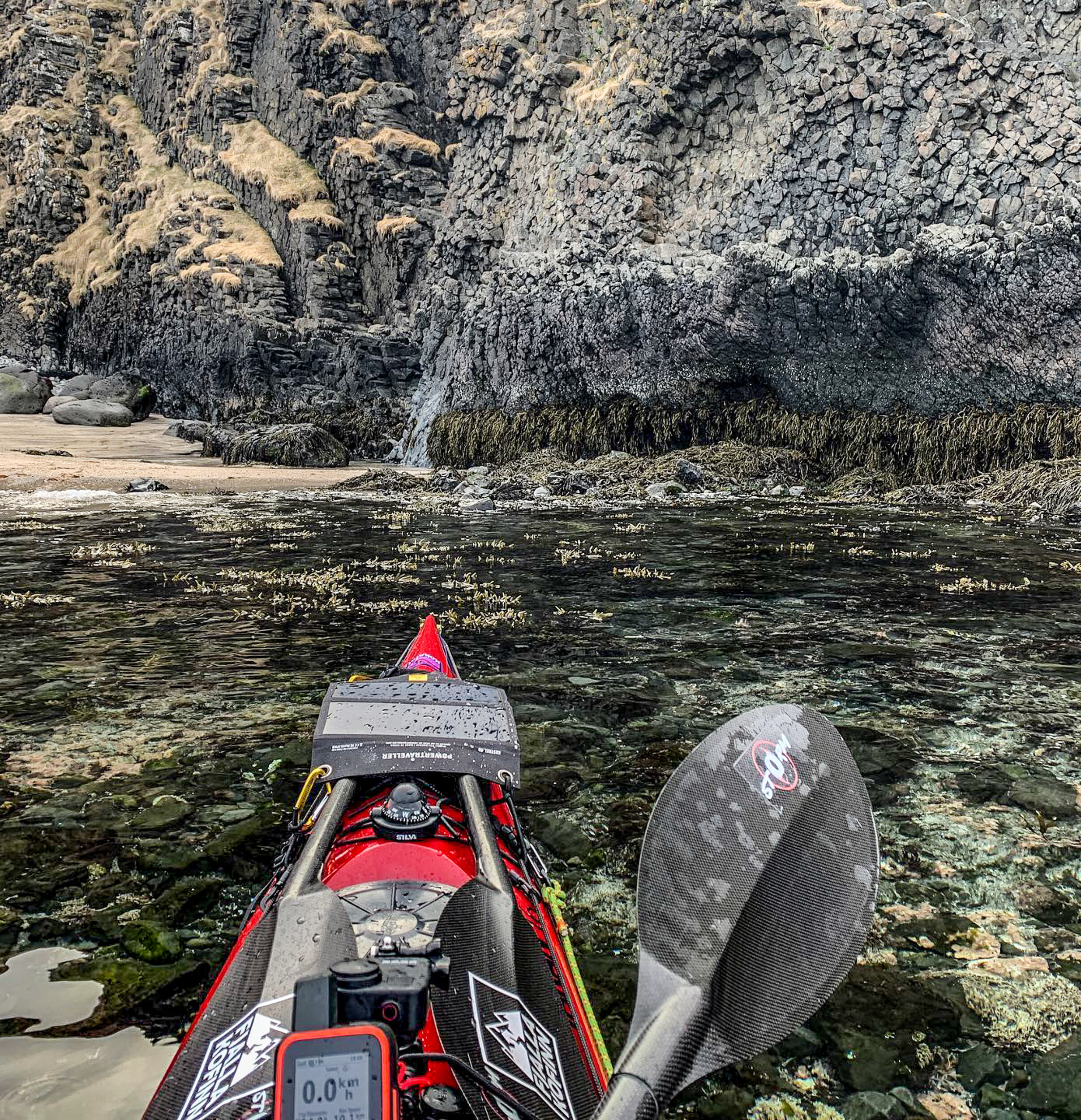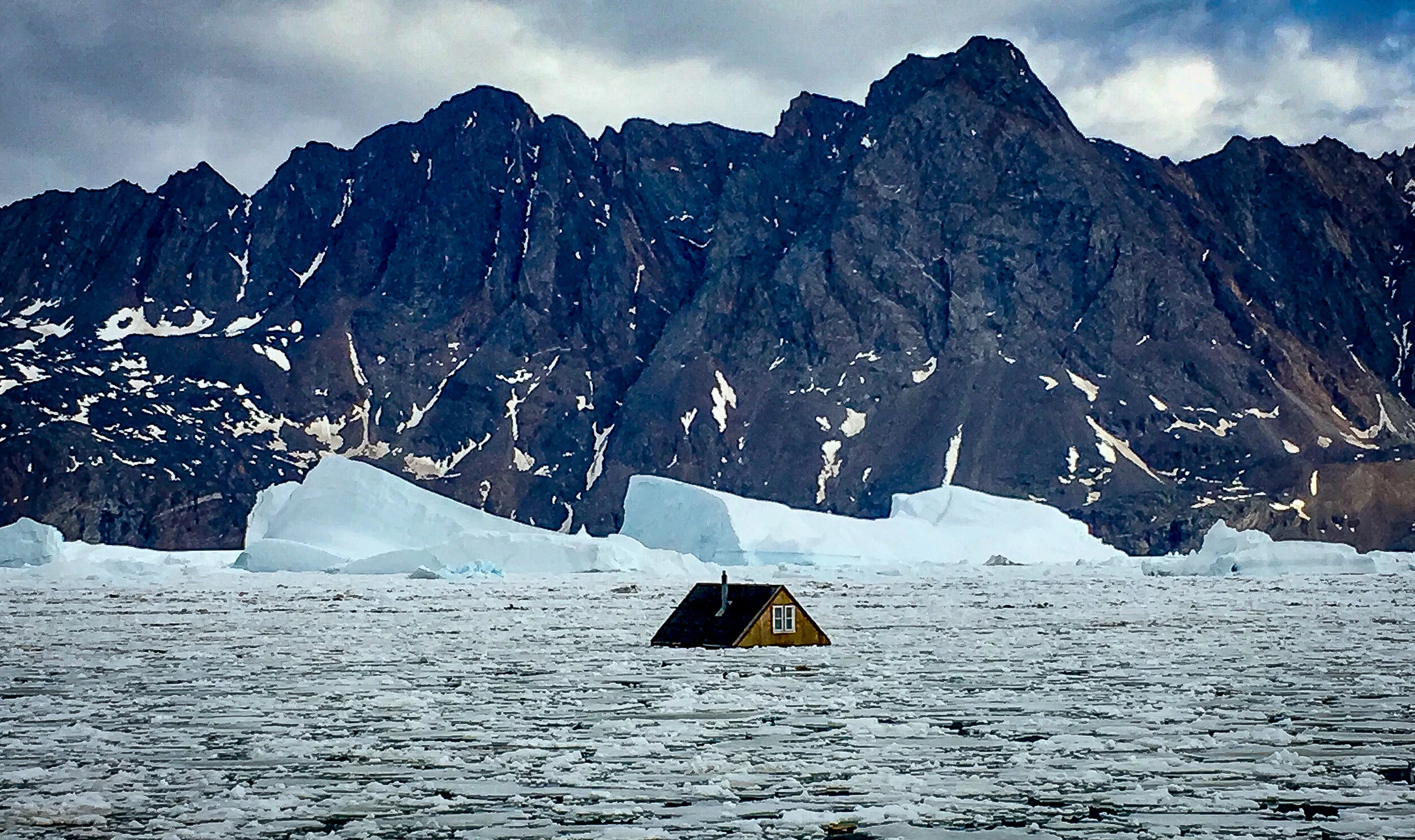Kayaking Against The Current To Clean Nordic Coastlines
ARCTIC TRAVEL / COMMUNITY
Writer: Vilborg Einarsdottir
Photographs: Veiga Gretarsdottir
March 2021
Kayaking has to be the ultimate way to travel in Iceland. In solitude, paddling across the ocean surface, somewhere alongside a largely uninhabited 4.970 km long coastline. Listening to the sound of seagulls while breathing in the serenity of northern nature and the beauty of the land. Embraced by waves of North Atlantic waters; Pure, fresh, still, and clean.
Well, not always so still - and apparently never so clean.
At least not in the perspective of where you are in the world. Kayaking by the shores of a country spanning 103,000km² with ample space (282m²) for each of its 365.000 inhabitants. But despite all that space and a small population, the shores of Iceland like other remote High North shores are littered with trash. Originating on land and offshore and always a result of human recklessness and environmental disrespect.
Having circumnavigated Iceland on roughly 100 days, Veiga Gretarsdottir came back ashore determined to make a difference. She has been a fierce promoter of cleaning the trash on Icelandic shores and later this year her mission expands to the shores of other High North countries, starting with a 3000 km kayak trip from the border of Russia and Norway close to the town of Kirkenes and down the coast to Tromsø, the Arctic capital of Northern Norway.
JONAA©Veiga Grétarsdóttir
There are several reasons why one falls in love with the sport of kayaking. Such as this; coming ashore and spending the night in magical nature with no one around.
Against The Current
Veiga Grétarsdóttir hit the headlines in 2019 when she achieved a goal set by many but reached by none before her. To circumnavigate by kayak the whole of Iceland - and to do so counterclockwise. That she achieved by paddling for 52 days in between weather stops and lecture days on the way, reaching the harbour of her hometown Ísafjörður in West Iceland a 103 days after she said farewell and set out on this challenging journey. A journey that has been compared to nothing less than reaching the top of K2 by those who know well the waters and the currents she paddled against.
Which fits perfectly with the name of her mission, turned into an ongoing project: Against The Current.
Veiga Grétarsdottir on her 2099 km long paddle around Iceland.
That name has a twofold meaning for Veiga, being a transgender woman who made the life-changing decision to become herself at the age of 38. But that story requires a whole other article, here we focus on the kayak trip and the Against the Current project that has now grown in Iceland and is on a path to be expanded to other Nordic countries.
JONAA©Veiga Gretarsdottir
And it is enough
“I started kayaking as a guide four years ago, both in Iceland and in Greenland,“ says Veiga, for whom the hobby turned into a profession, and the profession into a mission.
“Kayaking is simply the perfect way to travel. Really it’s the perfect way to experience being alive. Life is never as simple. You have the basic, minimal luggage with you and it is enough. The tent, the food, the basic gear and that’s it.
Then it is just you and nature, the ocean, the birds and the occasional seal or whale. Towards the end of the day you look around for some beautiful location where you can go ashore, stretch your legs, set up the tent, make a little campfire, cook something nice, listen to music and just breathe,” she says with a smile - adding, “it is a very therapeutic way to travel.”
No matter where you come close to shore, you are met with things that do not belong there. Most often torn pieces of household plastics or trashed nets and other fishing gear. But then there are these moments when the kayak brings you to remains that hold stories and secrets of lives lived and challenges faced. JONAA©Veiga Gretarsdottir
But then, there is the trash
Veiga’s project has since the Iceland trip focused largely on raising awareness of the vast and seemingly endless amounts of trash that washes up on our shores. A feature-length documentary titled “Against The Current”, was produced about the circumnavigation, premiered at RIFF, the Reykjavik Film Festival and shown on national television soon after.
“The response was truly heartwarming, both from critics and especially from the general public following the broadcast. I stayed up until the middle of the night answering emails and messages and phone calls from people I’ve never met. Interestingly, questions about kayaking and coastal cleaning were just as many as the ones about the whole transgender reassignment, which the film also discussed,” says Veiga. The documentary has now been nominated to Edda prize, the annual awards of the Icelandic Film and Television Academy.
“The thing is that most people don’t want to have our coastline littered with trash. They want to be able to walk down to a beach or sit on cliffs above a rocky coast and enjoy being in our beautiful outdoors. But in order for us to do so, we have to become so much more aware of the consequences of our actions when it comes to trash.
An old Icelandic saying “Lengi tekur sjórinn við” meaning basically “the ocean will endlessly accept whatever we dump in it,” simply is not true. The ocean returns whatever it can back to shore and the only way to change that is to change the way we treat it. Whether that is the individual who throws a piece of trash on the ground or out of the car window, the sailor who allows broken fishing gear to sink into the sea, the factories that dump waste into the waterways leading to the ocean or just the person who forgot to tie down their dumpster before a storm. There are so many ways for trash to reach the ocean and all of them are man-made. Alas, the solution has to be man-made as well.”
There is only so much the eye can see
“The romance of kayaking in unspoilt nature quickly fades as you begin to realise the incredible marine trash and pollution there is. Paddling is a slow way of travelling and you have ample time to observe the environment.”
“Of course, I had seen trash on just about any coast I had paddled by as a guide or on my private trips around Ísafjörður, regularly picking up floating trash and taking it back home. But it was not until on the Iceland trip that I realised just how much there is. Everywhere. In places where no one is and no one goes. On rocky shores, on sandy beaches, in caves and inlets. It’s everywhere and there is so much of it.”
Veiga continues. “Also, you become very aware of the fact that what you can see with your own eyes is only a portion of all there is. I have come across fishing gear and other marine trash so far inland that it makes no sense. But once the waves bring trash ashore, the wind often takes over and blows it onwards.
The very worst though is the trash that sinks to the bottom and gets tangled and stuck on stones or in the sand. Whenever I have paddled close enough to coast to see the ocean floor beneath me, there is trash in staggering amounts. Bearing in mind that my vision of the bottom is very limited from the kayak only lets you imagine the incredible amounts of trash polluting the ocean floor and threatening ocean life that we never see,” says Veiga.
A wake-up call
“The sheer amount of trash before my eyes every single day of circumnavigating Iceland was my wake-up call; to do something and do more than just make sure that I myself left nothing behind.”
“To get more people in the kayak and boating community to join hands in the cleaning project, to inspire others to take action and bring attention to our shores - and simply to advocate for travellers in Iceland to organize their travels around creating as little trash as possible. To make a habit of taking all trash back. And even better, to take a bit more than their own,” says Veiga.
“Of course, paddling in solitude for all these days gave me plenty of time to contemplate. So when I eventually came back home I had decided to seriously dedicate my efforts to cleaning shores and inspire others to do the same.”
Asked what kind of trash she encountered the answer is simple, “It takes less time to list what I didn’t see. It’s just about everything you can imagine. Most often fishing gear, nets, ropes, plastic strings, plastic bottles, plastic bags, plastic fish containers, floats and buoys.”
“Needless to say, most of what you see are things made of plastic, whole or broken down into small strings or grains. But then there are things like the unbroken light bulb floating past the kayak or the used paintbrush in a cave hundreds of kilometres from anyone’s home that you just stare at, wondering - how did you get here?”
JONAA©Veiga Gretarsdottir
Life is never as simple as when you kayak
“What I learned circumnavigating Iceland is that life is never as simple. I really just needed to be paddling, to eat, sleep and monitor the weather. Even though I was greatly limited in terms of what I could bring along and packing was a detailed puzzle prior to the trip, I also realised that all I brought, all that could fit with me into the kayak was really all that I needed. “
“I re-packed my food in order to lessen the weight and the trash I would bring back. Used, washed and re-used ziplock bags throughout the trip. Minimizing my own trash was something that I accounted for in the planning, but to be honest, I never accounted for or had the imagination of how much trash I would come across. Trash that I knew I could not take with me and trash I knew no one was coming to collect or remove.”
JONAA©Veiga Gretarsdottir
A never-ending project
“You soon realise that removing trash from the coast is a never-ending project. You may clean a beach this weekend and return in a month to fill up just as many bags of trash. But we have to do it. And there is an element of endurance and patience that you get to develop in the process. There is also the joy and love of knowing that you are doing your share. That is important.”
Being a serious kayaker has also affected Veiga´s life at home. “When I kayak, like on the Iceland trip, packing was a major issue. What you need is what you bring, but what you bring can only be so much in bulk and weight. Yet, it has to cover every basic thing you may need and there is no space for anything that is not a necessity.”
“On the trip, I was paddling with around 50 kilos of food, clothes, camping gear and whatever else I needed to be self-sufficient and sustainable.”
And,” she continues, “when you’ve mastered that and are back home, you start to look around and notice all the things you have that you neither need nor really use. Things that don’t give you any real pleasure to have, things that are just there. So I find myself drafting a plan of minimalistic living, in a smaller home with fewer things and just less stuff. There is freedom in that future thought.”
JONAA©Veiga Gretarsdottir
Next stop Norway
Veiga’s next destination for Against the Current is Norway in the summer of 2021. “I lived in Norway for several years, speak the language and it’s a country close to my heart. It is also a paradise for any kayaker, with its glorious coastline of steep mountains, deep fjords and beautiful islands.”
“Norway is in many ways an example to follow and authorities there have made a real effort and investment to protect the coasts and clean them of ocean trash. But of course one has no control over where the trash on your shores originates from,” says Veiga.
“A good example is my Norwegian Coca Cola bottle found on a remote beach in Iceland. I shared that story on a Norwegian Facebook page of an environmental cleaning group and soon a message popped up on my screen. Kan vi bytte? I was offered to trade my plastic Norwegian Coke bottle for an Icelandic plastic Kristal water bottle that had washed up on a Norwegian shore.”
Against the current from Kirkenes to Tromsø
Veiga has started planning and training for the Norway trip, where she will paddle in the company of Ciara Harrington, a kayaker from Ireland. The two-women team will set out from the border of Norway and Russia by the town of Kirkenes and paddle down the coast - against the current of course - to the Arctic capital of Tromsø.
A Norwegian-Icelandic film crew will document the 3000 km trip which is expected to last between three and four months, stopping at various places to meet with local kayakers, hold lectures, organise coast cleaning days and events and so forth. “There is great awareness of this issue in Norway and I am hoping to be joined by many local kayakers on different legs of the trip,” says Veiga. “If any people have a clear understanding of our coastal problems, it is kayakers. We see it from both sides.”
Following Norway, the plan is to take the project to Sweden, Finland, The Faroe Islands and Denmark - and even across the North Atlantic.
“At the end of the day, everyone who loves to kayak desires the same. To experience the expanse of the ocean, the tranquillity of nature, the birds and the silence. To be in harmony with yourself and the beauty of a world that is so much larger than you and only limited by the horizon. To paddle through an ocean where nothing is floating except your kayak and the occasional seabird. And to come ashore to an environment where you don’t have to remove trash to make space for your tent,” says Veiga Gretarsdottir. ▢
Camping on the vast black beach of Iceland’s south coast - after clearing a few square metres of trash to put down the tent. JONAA©Veiga Gretarsdottir
Further information on Veiga Gretarsdottir and Against The Current project on www.veiga.is and https://www.instagram.com/_againstthecurrent_/
Vilborg Einarsdottir is the Editor-in-Chief of JONAA, the Journal of the North Atlantic & Arctic and a JONAA partner & founder. Formally a journalist for 12 years at Morgunblaðið in Iceland, she has worked since 1996 as a specialised producer of film, photography and media productions on extreme locations in Arctic Greenland and as a cultural producer in the Nordic-Arctic region. She is an awarded film and documentary scriptwriter and editor of photography books from the Arctic.

















































